Discover the Unique Stories Behind America’s State Trees and Flowers Part 5: The West
The American West is home to a wonderful array of landscapes, from the Pacific coastlines to the Rocky Mountains. Each state in this region has chosen a tree and flower to represent its unique history and culture. These plants tell stories of survival and the deep connection between the people and the nature around them. Join us as we explore these living symbols, uncovering the stories and characteristics that make each choice special.
The Pacific Coast
The Pacific Coast states boast an amazing array of landscapes, from icy tundra to warm beaches. This unique geography can be seen through the state trees and flowers chosen by each of these states. As we explore these plants, we’ll uncover how they embody the spirit of the Pacific Coast—tough, diverse, and beautiful. From Alaska’s Sitka spruce to Hawaii’s bright native yellow hibiscus, each of these plants tells a story of survival, culture, and the breathtaking natural beauty that defines America’s western edge.
ALASKA

Sitka Spruce Trees in Fog – Photo by E Orlando on Unsplash
The Sitka spruce is Alaska’s state tree. It is the third tallest species of conifer tree in the world. These majestic trees can be over three hundred feet tall! This creates beautiful forests along the Pacific Northwest’s coast. Their impressive heights are matched by their long lives and size. Some of the oldest and biggest Sitka spruces have trunks that have diameters over eight feet and are five to seven hundred years old! These trees have stood witness to centuries of change, from Native American settlements to the Gold Rush and beyond. The Sitka spruce’s remarkable size and strength have made it good for many uses, like building airplanes during the World Wars. They are also good for making wood for musical instruments. The Sitka spruce’s ability to thrive in the harsh climate of Alaska as well as its magnificence make it a fitting symbol for the Last Frontier State.
While the towering Sitka spruce dominates Alaska’s skyline, the state’s official flower paints the ground with a more delicate touch. Alaska’s state flower is the forget-me-not . This flower is a charming and tough little plant that fits the spirit of Alaska well. These blue flowers have a very interesting trait: They have a strong scent in the evening and at night, but almost no scent during the day. This may help to attract insects that fly at night for pollination. Forget-me-nots can be either annuals or perennials, which means they can live for either one year or for many years, depending on the type and where it grows. In Alaska, the best time to see these blue flowers is in midsummer. This is usually between late June to late July. This is when Alaska has very long days, also known as its “midnight sun” season, so people can enjoy the beauty and smell of these flowers late into the night. The Forget-me-not can grow well in Alaska’s hard climate and has a short but memorable presence. This makes it a good symbol for Alaska, which is known for its wild beauty and short, intense summers.
HAWAII
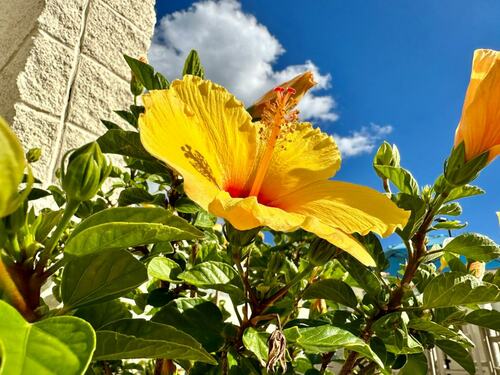
A Yellow Hibiscus Flower in Bright Sun – Image by Ted Balmer on Unsplash
Hawaii’s state tree is the candlenut tree, which is called the kukui nut tree in Hawaiian. It’s the only state tree that isn’t native to its country, but it’s been growing there for hundreds of years and is very important to Hawaiian culture. The tree is useful in many ways. Kukui nuts have a very high amount of oil in them, so native Hawaiians burned them for light. This is how they got the name “candlenut” in English. Hawaiians also used the wood to make canoes and ate small amounts of the “meat” inside the nut. Even the tree’s roots had uses. Today, people use hollowed-out kukui nuts to make leis, the famous Hawaiian flower necklaces. This tree’s many uses and importance to Hawaiian culture makes the kukui nut tree a fitting symbol for the Aloha State.
From the versatile kukui nut tree that lights up Hawaiian nights to a flower that shines like a miniature sun by day, Hawaii’s state symbols capture the islands’ diverse beauty. Hawaii’s state flower is the native yellow hibiscus, or “ma’o hau hele” in Hawaiian. This flower only grows in Hawaii and holds a special place in Hawaiian culture. Its name means “green traveling hibiscus,” possibly because the yellow flowers turn green when they fall off. Hawaii has many kinds of hibiscus, but they chose the yellow one as the official state flower in 1988. Before that, all hibiscus colors were included as the state flower since the 1920s. The ma’o hau hele blooms all year, but each flower only lasts for a single day. Its short-lived beauty, bright color, and importance in Hawaiian culture make it a good symbol for Hawaii.
CALIFORNIA
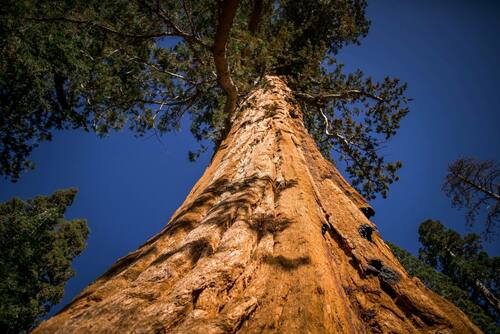
A Towering Coastal Redwood – Image by Sinjin Thomas on Unsplash
California has two state trees: the coastal redwood, and the giant sequoia. These trees are very old, dating back to dinosaur times.
Coastal redwoods
are the tallest trees in the world. They can grow up to four hundred feet tall and one hundred feet wide! These giants can grow between two and ten feet yearly, can weigh up to 1.4 million pounds, and can live up to two thousand years. Giant sequoias also hold an impressive title: These trees are the largest trees in the world by volume. The biggest giant sequoia has 52,508 cubic feet of wood. While not as tall as coastal redwoods, these trees can grow up to three hundred feet tall and weigh up to 2.7 million pounds! Their trunks can be up to forty feet wide, with bark up to thirty-one inches thick. Talk about a behemoth! Another interesting fact about giant sequoias is that they actually need forest fires to grow: The heat from these fires opens the seeds and clears the forest so they have space to grow. Giant sequoias can live up to an amazing three thousand years—this makes them one of the oldest living things in the world! Together, these two species of trees show California’s diverse nature and efforts to protect important parts of nature.
While California’s state trees reach for the sky and span millennia, its state flower paints the ground with a more fleeting beauty. The
California poppy
, which has been the state flower since 1903, is a colorful symbol of the Golden State. Its bright-orange flowers are said to represent the gold that brought many people to the state during the Gold Rush. These cheerful flowers bloom in the spring and summer, bringing a golden hue to the roads they grow along throughout the state. It’s easy to see how important this flower is to the people of California; they even have a special holiday for it! On April 6th, people come together to show their love for this flower and how much it means to the state of California.
OREGON
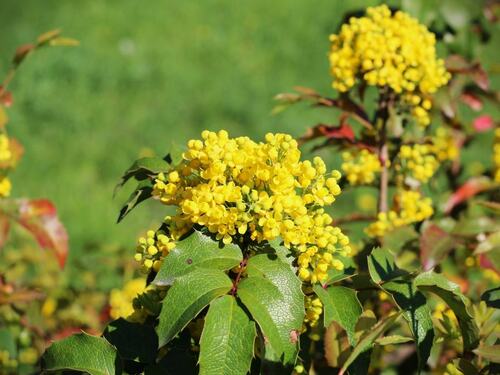
Oregon Grape Flowers in Bloom – Photo by Marina Yalanska on Unsplash
The Douglas fir , Oregon’s state tree, is a majestic conifer that has adapted well to its environment. One of its most interesting features is its thick, cork-like bark. This bark can grow up to a foot thick on older trees and protects them from forest fires. This fire resistance is especially helpful now that wildfires are more common in the Pacific Northwest. This gives Douglas firs a better chance of survival than other trees, which is why you’ll find these trees all over Oregon. From coastal regions to mountain slopes, the Douglas fir stands tall as a symbol of nature’s creativity in the face of challenges.
While the Douglas fir reaches skyward with its fire-resistant bark, another of Oregon’s state symbols proves that great things come in smaller packages. The Oregon grape, the state flower of Oregon, is an adaptable and beautiful plant native to the Pacific Northwest. This shrub is loved for its bright-yellow flowers that bloom in early spring, adding a splash of color to the state. But this plant isn’t just pretty to look at—it’s also quite useful. Native Americans and modern crafters have found that the inner bark of the Oregon grape can be used to make a bright-yellow dye, matching the color of its flowers. This dye is great for coloring fabrics, baskets, and other items. This plant is a perfect example of Oregon’s natural beauty and practical resources rolled into one plant. It connects Oregon’s environment with its culture and traditions, making it a good symbol to represent this state.
WASHINGTON

A Branch of Western Hemlock – Image by Liliana Ildiko from Pixabay
The western hemlock was chosen as Washington’s state tree in 1947. It is a majestic conifer that embodies the lush evergreen forests of the Pacific Northwest. This tree is native to the west coast and can be found from Alaska down to northern California. The western hemlock thrives in the cool, moist climate of Washington state. As the largest species of hemlock, it can grow up to two hundred feet tall and live for over five hundred years! It has been crucial to the state’s forestry and has been valued for its strong, light-colored wood used in construction and making paper. The tree is also important culturally. Native Americans used its tannin-rich bark for cleaning and tanning hides. This high tannin content enhances the tree’s resistance to decay so it can live a long life. The western hemlock’s ability to grow in the shadows allows it to establish itself in mature forests. Because of this, it can become the dominant species over time. Its importance to the economy and its cultural significance make it a good symbol of Washington’s history and forestry traditions.
While the western hemlock reigns supreme in Washington’s forests, another plant, though less majestic, holds its own place in the state’s heart and history—a flowering shrub that bloomed into significance long before it was officially recognized. The coast rhododendron , often referred to as “rhodies” by locals, is the state flower of Washington, and is a native plant of the Pacific Northwest. It’s also called the “Pacific rhododendron” or the “big-leaf rhododendron.” Despite its official status, this shrub has a somewhat scraggly appearance and is rather hard to grow, making it less popular in gardens than other species of rhododendron. Growing up to twenty feet tall, the coast rhododendron is the western counterpart of the eastern rhododendron. However, despite not being as popular as its relatives, it has a noteworthy history in Washington; in 1892, before women had the right to vote, Washington women selected the coast rhododendron to represent the state at the 1893 World’s Fair in Chicago.
The Rocky Mountains
The Rocky Mountain states are known for their tough terrain, diverse habitats, and extreme weather. This challenging but beautiful landscape is reflected in the state trees and flowers chosen to represent this region. As we journey through the Rockies, we’ll explore how these plants embody the strength and unique beauty of the region. From Colorado’s blue spruce to Wyoming’s Indian paintbrush, these plants tell stories of survival, culture, and the diversity that defines America’s backbone. Each chosen tree and flower offers a glimpse into what makes these mountain states special both in nature and in history.
COLORADO
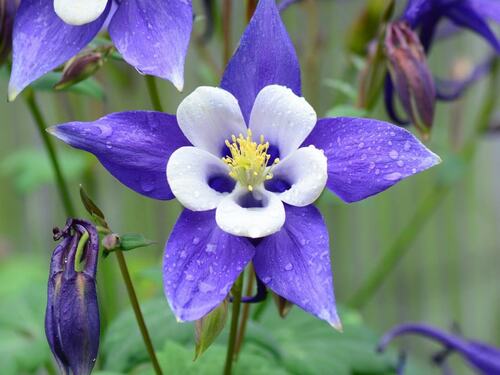
A Gorgeous Rocky Mountain Columbine Flower – Image by Bryan Hanson from Pixabay
The blue spruce is Colorado’s state tree. It is known to have a deep history and significance. It was first chosen as the state tree by the children of Colorado in 1892 on Arbor Day. It didn’t become the official state tree until 1939, though. The blue-green needles of this tree are not only pretty but are also important in many ways. Native American tribes like the Keres and Navajo have used these needles to treat things like colds, stomach issues, and joint pain. This tree is also popular in modern times as a Christmas tree. The blue spruce can grow very quickly; it usually grows twelve inches per year but can shoot up to two feet in a year in good conditions. This steady growth is a symbol of Colorado’s progress and strength, making it a good symbol for the state.
Imagine a flower so pretty, it’s like Colorado’s mountains have decided to bloom. That’s the Rocky Mountain columbine, Colorado’s state flower since 1899. This special plant is known for its unique blue petals, white center, and long spurs. Its beauty and rarity have made it a beloved symbol of Colorado’s diverse and spectacular mountain ecosystems. Understanding its importance, Colorado passed a “don’t touch” law for these flowers in 1925, making it illegal to dig them up or pick them. This helps make sure the flowers will still be around for people to enjoy in the future. Today, the Rocky Mountain columbine remains a protected species, serving as a living reminder that sometimes the best way to appreciate beauty is to let it grow wild and free.
IDAHO
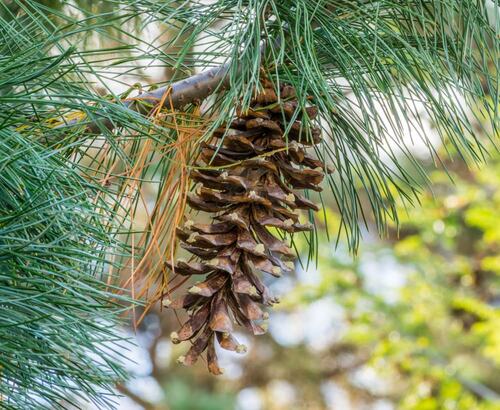
A Branch & Cone of Western White Pine
Idaho chose the western white pine as its state tree in 1935, and it’s easy to see why. These giants once ruled northern Idaho’s forests, growing up to two hundred feet tall with straight, smooth trunks. Timber companies loved them, and these trees helped build Idaho’s economy, especially in the northern part of the state. Their wood was perfect for building houses and making furniture. But in the 1900s, these mighty pines faced a tough enemy—a fungus that made many trees sick. People didn’t give up, though. They started programs to save the western white pines and grow stronger ones. Now, these tough trees are making a comeback in Idaho’s forests. They’re more than just trees—they’re living reminders of Idaho’s natural beauty and its long history with forests.
While the western white pine dominates Idaho’s skyline, another plant holds equal importance in the state’s heart. Since 1931, Idaho has proudly honored the syringa as its state flower. This hardy bush is as versatile as the state itself. Affectionately nicknamed the “mock orange,” the syringa is known for its fragrant, four-petaled white flowers. These flowers bloom between late spring and early summer, filling the air with a sweet, orangelike scent. This tough plant grows in the wild all around Idaho, especially near streams and in open woods where the soil is moist but drains well. The flower got its name from Meriwether Lewis, who was part of the Lewis and Clark trip and had written about the plant during his travels through Idaho. Chosen for its local roots and ability to adapt, the syringa embodies the spirit of Idaho: tough, beautiful, and right at home in both gardens and on mountains. It’s not just a state flower; it’s Idaho’s natural ambassador, blooming proudly year after year in a celebration of the Gem State’s wild landscape.
MONTANA
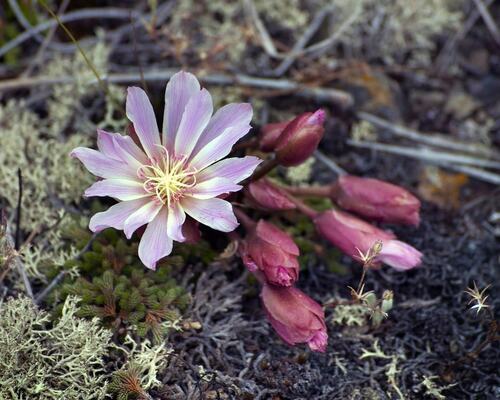
A Pale-Pink Bitterroot Flower – Image by M. from Pixabay
The ponderosa pine is Montana’s state tree. It’s an impressive tree that both looks and smells nice. One of its special features is that its bark smells sweet, like vanilla or butterscotch. This sweet smell is even stronger on warm, sunny days in older trees. The scent comes from the sap in the tree. Besides its sweet-smelling bark, the ponderosa pine is very tall: It can grow up to 150 feet or more. Its long needles (usually in groups of three) and big pinecones add to its impressive look. This tree is native to the American west and grows well in Montana’s different climates, from its mountains to its plains. It also plays an important role in nature, giving wildlife places to live and keeping the soil from eroding. Its selection as the state tree in 1949 shows how important it is to Montana’s landscape, ecology, and cultural history.
From the towering state tree, we turn to Montana’s official flower, which grows close to the ground but is no less significant. The bitterroot has been Montana’s state flower since 1895. It’s a hardy plant with a history. This little plant grows in the rocky areas of western North America. It gets its name from its bitter-tasting roots. These roots are very nutritious. Native American tribes would dry the roots and use them as food when other food was scarce. When they are dried, the roots can be used as a source of calories and nutrients to sustain people during harsh winters or long journeys. The bitterroot’s Latin name is “rediviva,” which means “brought back to life.” This name shows how this plant can survive harsh, dry conditions, even appearing to be dead at times, but can be revived with moisture. In the late spring and early summer, the bitterroot’s striking pink-to-white flowers bloom. These flowers create a beautiful contrast against the rocky landscape. The bitterroot’s beauty, strength, and usefulness make it a good symbol of Montana’s rugged beauty and the cleverness of its people.
NEVADA
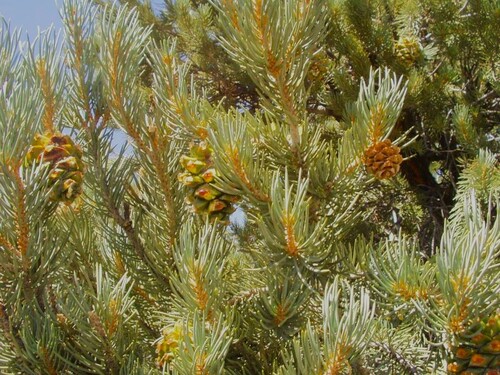
Cones & Needles of a Single-Leaf Pinyon – By en:User:Toiyab , Wikimedia Commons , CC BY-SA 3.0
Nevada’s state tree, the single-leaf pinyon, is a tough little pine that thrives in dry, mountainous areas. What makes it special are its needles—they grow one by one instead of in bunches like other pines. These needles are usually one to two inches long and bluish green in color. This tree only grows around fifteen to thirty-five feet tall, but it’s important for both people and animals. It’s best known for its pine nuts, which have been an important food source that native peoples have eaten for thousands of years. The tree has a symbiotic relationship with the pinyon jay, who eats these nuts as well and helps spread the tree’s seeds. While the single-leaf pinyon is good at surviving in harsh conditions, it faces challenges from climate change and wildfires. This tree shows us how plants can adapt to tough environments and reminds us why we should take care of our unique natural treasures.
While the single-leaf pinyon represents Nevada’s hardy tree life, another plant dominates the state’s landscape and embodies its rugged character. The sagebrush, specifically the big sagebrush , was designated as Nevada’s state flower in 1917. This hardy shrub grows well in Nevada’s dry climate and has small yellow-green flowers in late summer. It’s so common that Nevada is called “The Sagebrush State.” Native Americans and early settlers found many ways to use sagebrush in their daily lives. They made tea from its leaves to help with stomach problems and colds. They also used its bark to make rope and its soft leaves to stuff mattresses and make warm blankets. While sagebrush is great at surviving in harsh conditions, it faces challenges from wildfires and land development. This plant shows us how nature can be both beautiful and practical and reminds us of the clever ways that people have learned to live with their environment.
UTAH

A Sego Lily in a Grassy Field – Image by stephmcblack from Pixabay
The quaking aspen became Utah’s official state tree in 2014, replacing the blue spruce, which had held the honor since 1933. This change reflected a growing appreciation for the quaking aspen’s unique characteristics and its significance to Utah’s ecosystem. The tree’s most distinctive feature is its leaves, which are flat and are attached to long, flattened stalks called petioles . This structure allows the leaves to tremble or “quake” in even the slightest breeze, creating a mesmerizing visual effect and a soothing, rustling sound that’s often described as “nature’s whisper.” This constant movement isn’t just aesthetically pleasing; it also helps the tree photosynthesize more efficiently and reduces wind resistance. Quaking aspens are known for their extensive root systems, which can give rise to entire groves of genetically identical trees, making them one of the largest living organisms on Earth. In Utah’s mountainous regions, these aspen groves create stunning golden displays in autumn, attracting visitors from around the world. The quaking aspen’s ability to thrive in Utah’s varied climate and its role in supporting diverse wildlife make it a fitting symbol for the state’s natural beauty and ecological richness.
From the towering Quaking Aspen that adorns Utah’s mountains, we turn to a more humble but equally significant plant that has sustained life in the state’s arid lowlands. The sego lily, Utah’s state flower since 1911, holds a special place in both the natural and cultural history of the state. Its name derives from the Shoshonean word “sego,” believed to mean “edible bulb,” highlighting its importance as a food source. This resilient plant thrives in Utah’s desertlike conditions, with seven variations found across the state, showcasing its adaptability. The Sego Lily played a crucial role in Utah’s pioneer history, helping to stave off hunger for Mormon settlers. These early pioneers ate the l


